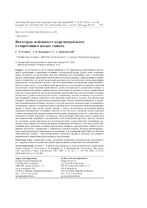| dc.contributor.author | Осипов, С. Н. | ru |
| dc.contributor.author | Захаренко, А. В. | ru |
| dc.contributor.author | Данилевский, С. А. | ru |
| dc.coverage.spatial | Минск | ru |
| dc.date.accessioned | 2018-04-06T11:51:47Z | |
| dc.date.available | 2018-04-06T11:51:47Z | |
| dc.date.issued | 2018 | |
| dc.identifier.citation | Осипов, С. Н. Некоторые особенности энергопотребления в современных жилых зданиях = Some Specific Features of Energy Consumption in Modern Residential Buildings / С. Н. Осипов, А. В. Захаренко, С. А. Данилевский // Энергетика. Известия высших учебных заведений и энергетических объединений СНГ. - 2018. - № 2. - С. 141-158. | ru |
| dc.identifier.uri | https://rep.bntu.by/handle/data/40072 | |
| dc.description.abstract | За последние 20 лет в странах бывшего СССР произошли существенные изменения в требованиях к жилищным условиям у покупателей жилья. Кроме этого, появились новые материалы и строительные изделия, например для герметичных окон и балконных дверей. Значительно увеличилось количество пустующих квартир с выключенным в зимнее время отоплением, что может вызвать конденсацию влаги на поверхностях межквартирных перегородок и образование плесени. При этом требования к уменьшению энергопотребления постоянно растут, что особенно явно проявляется в нормативном повышении значений термических сопротивлений ограждающих здания конструкций и увеличении интереса к использованию вторичных энергоресурсов, получаемых из воздуха и стоков отработанной воды. В статье описан способ предотвращения конденсации влаги на ограждениях смежных помещений с разной температурой воздуха, содержащих системы отопления и использования вторичной теплоты удаляемого из помещения отработанного воздуха. Для обеспечения быстрого аварийного подключения внутридомовых систем теплогазоснабжения к наружным передвижным источникам теплоты и газа рекомендуется дополнительно устанавливать специальные отводы с соединительными устройствами в специальных теплоизолированных нишах в стенах или других частях зданий с учетом возможности размещения вблизи наружных передвижных источников теплоты и газа. В случае отопления здания крышной газовой котельной или поквартирными отопителями, питаемыми газом, по стене дома прокладывают единый газопровод (коллектор), оборудованный дополнительным устройством для подключения аварийного газоснабжения. Для уменьшения удельного расхода теплоты на отопление зданий рекомендуется при модернизации и реконструкции увеличивать полезный объем зданий и улучшать их формы различными способами, в том числе путем объединения двух или более соседних малоэтажных зданий в одно вторичное здание с повышением этажности, с уширением с любой или с каждой стороны. Размеры реконструируемого здания принимают максимально возможными, а их пропорции (при любом количестве объединяемых зданий) − обеспечивающими стремление формы к шаровой, или равноцилиндрической, или кубической при любом их сочетании. | ru |
| dc.language.iso | ru | ru |
| dc.publisher | БНТУ | ru |
| dc.subject | Modern housing | en |
| dc.subject | Empty premises | en |
| dc.subject | Moisturizing of partitions | en |
| dc.subject | Emergency heat and gas supply | en |
| dc.subject | Reconstruction of buildings | en |
| dc.subject | Heat consumption reducing | en |
| dc.subject | Современное жилье | ru |
| dc.subject | Пустующие помещения | ru |
| dc.subject | Влаговыпадение на перегородках | ru |
| dc.subject | Аварийное теплогазоснабжение | ru |
| dc.subject | Реконструкция зданий | ru |
| dc.subject | Уменьшение теплопотребления | ru |
| dc.title | Некоторые особенности энергопотребления в современных жилых зданиях | ru |
| dc.title.alternative | Some Specific Features of Energy Consumption in Modern Residential Buildings | en |
| dc.type | Article | ru |
| dc.identifier.doi | 10.21122/1029-7448-2018-61-2-141-158 | |
| local.description.annotation | Over the past 20 years there have been significant changes in the customer requirements for housing in the countries of the former USSR. Besides, new materials and construction products, such as the ones for sealed windows and balcony doors have appeared in the market. The number of vacant flats with the heating off in the winter significantly increased that may cause condensation on the surfaces of interroom partitions and the formation of mold. Meanwhile, the requirements for lower energy consumption are constantly increasing, that is especially pronouncedly manifested in the growth of normative values of thermal resistance of enclosing structures of buildings and in the increased interest in the use of secondary energy resources extracted from the air and effluent wastewater. The present article describes the method to prevent moisture condensation on the fencing of adjacent premises with different temperatures containing heating systems and the use of waste heat removed from the room exhaust air. For quick emergency switching of in-house systems of heat and gas supply to outdoor mobile sources of heat and gas it is recommended to install special taps with connectors insulated in special niches in the walls or other parts of buildings considering the possibility of placing them close to the outer mobile sources of heat and gas. In the case of heating the building with the aid of a roof gas boiler or by door-to-door heaters fueled by gas, a single pipeline (collector), equipped with an additional device for the connection of emergency gas supply is being put along the wall. In order to reduce specific heat consumption for heating of buildings it is recommended to increase the net enclosure volume of buildings and to improve their form in various ways, including by combining two or more adjacent low-rise buildings in one secondary building with increasing height and with the broadening of either or each side for modernization and reconstruction. The dimensions of the reconstructed building are accepted as the maximum possible, and their proportions (in any number of merged buildings) – as providing tend of shapes to spherical or equicylindrical, or cubic – in any combination. | en |

